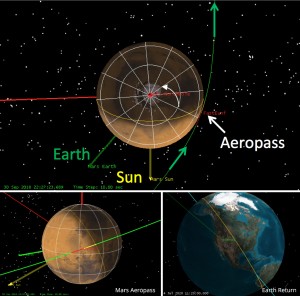15 Jul Space: Mars Sample Return by BoldlyGo Institute
[caption id="attachment_42" align="alignleft" width="300"] In 2020, SCIM will embark on a two year journey to Mars to perform a high-speed atmospheric pass collecting tiny dust particles. SCIM will take another half year to return the samples to Earth for detailed analysis. Source: BoldlyGo Institute[/caption]
In 2020, SCIM will embark on a two year journey to Mars to perform a high-speed atmospheric pass collecting tiny dust particles. SCIM will take another half year to return the samples to Earth for detailed analysis. Source: BoldlyGo Institute[/caption]
A nonprofit corporation called BoldlyGo Institute (BGI) is developing a Mars Sample Return mission called the Sample Collection to Investigate Mars (SCIM) which will return the first samples of Martian materials back to Earth. The project is at the preliminary design stage and the goal is ambitious. With a launch date of July 26, 2020, SCIM will journey through space for two years. When it reaches Mars, it will swoop down and collect the dust particles from the Martian atmosphere below 40 km. The SCIM has an aerodynamic aeroshell allowing it to rapidly pass through the atmosphere without being captured by Mars's gravity. The sample capture mechanism for the Mars Sample Return Mission is similar to the successful collection system for the Stardust mission which used aerogel to capture dust particles. After collecting thousands of particles, the spacecraft will leave Mars on August 3, 2022 and return directly to Earth by February 1, 2023 where the sterilized samples will descend by parachutes to the ground.


